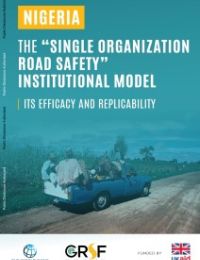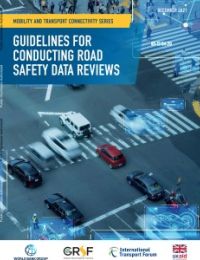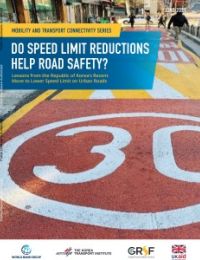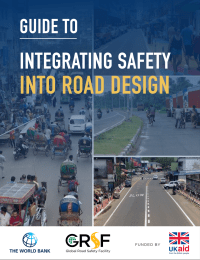Publications
21-30 of 59
-
-
Speed Management
Road Crash Trauma, Climate Change, Pollution and the Total Costs of Speed: Six Graphs That Tell the Story
July 2022
-
-
Road Safety Management
Nigeria: The “Single Organization Road Safety” Institutional Model, its Efficacy and Replicability
July 2022
-
What are the strengths and weaknesses of this model and what could be done to improve its’ efficiency and effectiveness?
-
How efficient and effective is the “Single Organizational Model” institutional setup (both federal and state levels) in dealing with the road safety issues in Nigeria?
-
Can this model be replicated in other LMICs and what are the factors that will determine the replicability of the model in those countries?
-
What are the steps in setting up “Single Organizational Model” institutions in LMICs?
-
-
Speed Management
Guide for Determining Readiness for Speed Cameras and Other Automated Enforcement
July 2022
-
To briefly identify the powerful practical value of AE in saving lives and reducing injuries.
-
To identify issues and criteria to be considered before commencing automated enforcement. To identify steps to be taken to achieve readiness for automated enforcement. To identify issues to improve existing automated enforcement systems.
-
To provide a checklist to ensure adequate consideration is given to issues to assess readiness to implement an AE system or improve an existing system.
- Evaluate the effectiveness of the reduced speed limits in terms of crash reduction through a before-after study.
- Examine if the speed limit change had different effects across different crash types, user types, and crash severities.
- Evaluate the impact of speed limit change on transit speed through a before-after assessment.
- Develop appropriate and actionable recommendations for departments of transportation in developing countries.
-
Road Infrastructure
Guide pour l’Intégration de la Sécurité dans la Conception des Routes (French)
July 2022
-

The World Bank estimates a significant funding gap in road safety of 260 billion to achieve SDG 3.6 and 11.2 in the next ten years, and recognizes that this gap cannot be closed through public funding alone and thus mobilization of private capital is required. The impacts of road traffic crashes reach far into the economy and can cost L/MICs as much as 6% of their GDP. The costs of a road traffic crash do not end at the roadside; they create ripple effects throughout the wider economy. Loss of income, property damage, insurance premiums, loss of taxes, and burdens on the health sector are just some of the far-reaching costs associated with road traffic crashes. Road traffic crashes can cost countries as much as 6 percent of their GDP and trap families in poverty as they lose income generating potential and focus on providing lifetime care.
This report examines the potential for private capital mobilization to close this gap. The report investigates the market failure to appropriately account for the cost of road crashes, which prevents private capital from flowing to road safety investments. The growth of socially responsible investing and the sustainable finance market offers a new opportunity to address this market failure. The report proposes different business models and financing instruments to channel private investment into road safety projects. These investment structures consist of subnational, public-private partnerships (PPPs) and corporate investments that can leverage the growing sustainable finance market, including social and sustainability-linked financings (SLFs).
The report also develops indicators that can be used to tie the cost of financing to the attainment of road safety targets, incentivizing borrowers to commit to road safety as part of SLFs. The report examines the enabling environment for structuring investable road safety projects in a sample of countries, looking at the barriers and opportunities, and proposing risks and mitigation strategies, like blended finance mechanisms and stable revenue sources, for long-term sustainability of road safety investments.

What is the real cost of speeding on people and the environment? These 6 graphs tell the story ⌵︎
The impacts of speed on the safety of road users, on congestion, on pollution, and on total costs of road travel are broadly misunderstood: often based on wrong assumptions, with effects taken as self-evident, failure to consider multiple impacts, externalization of costs by many stakeholders, and under-estimation of impacts (especially economic costs of higher speeds). The purpose of this brief note is to provide information on these relationships relevant to fundamental road transport policies, design, and operation. Well-established evidence shows the importance of managing travel speeds for road safety, for efficiency, for improved inclusion, and for greenhouse gas (GHG) and other emissions. Thus, speed management is a strong policy lever for the breadth of issues which must be addressed for sustainable mobility.
Reduced speeds of travel represent a major, yet under-appreciated, opportunity to improve safety, climate change impacts of travel, health, inclusion, the economy, and in some circumstances, congestion. Speed management can be achieved through a range of interventions including road infrastructure and vehicle technology, as well as enforcement and promotion.
The six graphs presented in this note tell a powerful story, across the range of these benefits of speed management.
This publication is also available in:
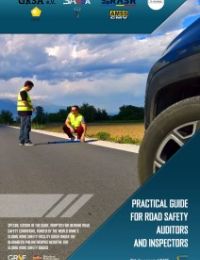
After almost two decades of experience with Road Safety Audit (RSA) Worldwide, this procedure is now recognized as one of the most efficient engineering tools. RSA is a highly efficient and cost-effective engineering tool for improvement of safety on roads. It is much cheaper to identify road safety deficiencies in the process of design than later after construction is completed. RSAs are among the most cost-effective investments a Road Authority can undertake.
With its EU Directive No. 2008/96 and amendment 2019/1936 on road infrastructure safety management, the European Union (EU) made a clear decision that RSA will be mandatory for the Trans-European Road Network (TERN) and main roads. This Directive contains another tool called Road Safety Inspection (RSI) on safety deficiencies of existing roads. The RSI is very similar to the process of Road Safety Audit in the pre-opening phase of newly constructed roads. RSIs are essential for the redesign and upgrading of existing roads, and these are done in many countries to give the designers insights and direction for safety improvements. Given that, the purpose of this practical guide is to provide practical guidance to those doing RSAs and RSIs, the examples of typical design deficiencies shown should be useful to both road safety inspectors and road safety auditors.
This document draws on the more comprehensive guidelines and manuals on Safety engineering mentioned in the acknowledgements but deliberately focuses only on these issues of direct relevance to road safety auditors/inspectors and to the road safety reports that they must prepare, including of recommendations for improvements.
This is a special edition of the guide, adapted for Ukraine road safety conditions and legislation, funded by the World Bank‘s Global Road Safety Facility (GRSF) under the Bloomberg Philanthropies Initiative for Global Road Safety (BIGRS).
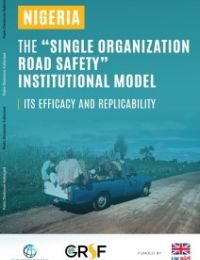
This study is one part of a comprehensive study of lead road safety agencies in low- and middle-income countries (LMICs), which is being conducted on a collaborative basis by the World Bank, the World Health Organization, and the African Development Bank. This particular study is supported by UK Aid through the World Bank’s Global Road Safety Facility (GRSF). It focuses on the case of Nigeria, a federal republic with three tiers of government - federal (central), state and local governments - and its single institutional model for road safety.
This report responds to the following questions:
Download the report to learn more!
RESOURCES ⌵︎
ACKNOWLEDGMENTS ⌵︎
‘The “Single Organization Road Safety” Institutional Model, its Efficacy and Replicability’ Study is supported by UK Aid through GRSF. The Report was written by three main authors: Martin Small, Mustapha Azzouzi and Arpita Roy. The study was led by Farhad Ahmed (Senior Transport Specialist) with support from Md. Towshikur Rahman, who was responsible for the overall coordination.
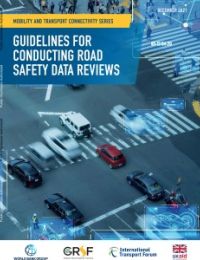
Download the document in English
Download the document in French
Download the document in Spanish
In many countries around the world, deficiencies in data or data quality impair evidence-based road safety policy making. While many countries collect road safety data, the collection is not necessarily comprehensive. Further, many countries can be unaware of data gaps in their system, which prevents them from soundly analyzing their road safety problems. Therefore, road safety data definitions and collection methods must converge into standard international criteria, thus allowing for comparisons in space - across countries - and in time.
This is the raison d’etre of regional road safety observatories, which have been developed, for example, in Latin America (OISEVI), Africa (ARSO), and Asia-Pacific (APRSO). They present an opportunity for joint regional efforts to improve, in a harmonized way, road safety data collection and analysis. Regional road safety observatories promote the adoption of a common set of road safety indicators based on common definitions and serve as an avenue to assist countries in improving the management of their crash data systems.
This document is designed to support reviewers in the assessment of road safety data collection; the complete range of safety data should be considered. This task can be complicated because collection of road safety data is often not achieved by activities dedicated to this purpose, but rather through piggybacks on other sources. For example, activity reports from police or hospitals are used to provide material for legal or medical purposes. The routines involved frequently have a long history in which gathering reliable and complete statistics has had secondary priority, at best. The various actors involved reflect the complex structure of a country’s judicial and executive system, which, generally, are not coordinated. Consequently, any review of the data collection process requires some “detective work.”

This guide has been prepared to assist a jurisdiction to determine the level of readiness to move to automated enforcement (AE). Speed cameras enforcing speed limits are a common application of AE and there are many systemic legal and operational elements that must be in place before AE can be effective. For example, an accurate image of a speeding vehicle, in the absence of robust driver licensing and vehicle registration systems, is of little road safety value. Importantly, automated speed enforcement should be considered as one part of a comprehensive speed management approach that includes road infrastructure and roadside policing as well. The management of speed is a fundamental element of the Safe System.
Aims of this document:
Other illegal behaviours, including disobeying a red light signal, mobile or cellular phone use, incorrect lane use, and non-restraint use can also be detected using an automated enforcement approach. However, this document applies specifically to automated speed enforcement, because speed management requires significant attention worldwide and plays a critical role in reducing road traffic deaths and injuries.
Document also available in French, Portuguese, Vietnamese and Spanish.
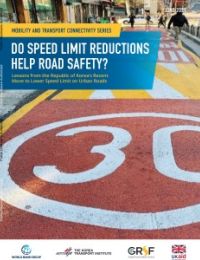
Significant research has been undertaken on how changes in speed limit—for example, the introduction of 30 kilometers per hour, or kph (20 miles per hour, or mph) speed limits—impact safety both when combined with, and without "traffic-calming" engineering treatments such as speed humps or raised platforms. However, most of the studies have been conducted in Australia or countries in Western Europe, with almost no recorded studies from Asia, Africa, the Americas, and Eastern Europe. Though it may be reasonable, a well-developed infrastructural environment such as that found in Korea would expect similar results as that of the western countries, a study originating in Asia could have a strong demonstration effect and prove very convincing for many Asian countries.
With this in mind, the main aim of this study is to present the findings from Korea’s reduced speed limits on safety performance and to support the establishment of suitable speed-management strategies based on a quantitative data-driven approach. The scope of the project was as follows:
To start, this report first provides a brief literature review on the concept of Safe System speed limits, and the effect of speed limit reductions as part of speed management in several countries, followed by a brief description of the evaluation methods for the before-after assessment. This is followed by a summary of the findings, a set of recommendations, limitations of this study, and finally, a capsule of future research that could be undertaken to either extend or follow up on the study.
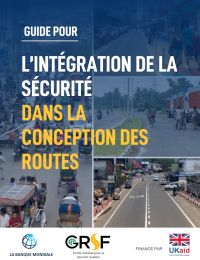
Ce guide se concentre sur les éléments des conceptions de routes et de bordures de route sûres pour les réseaux routiers qui peuvent offrir une mobilité sûre à tous les usagers de la route.
Une réduction substantielle des décès sur les routes ne sera réalisable que si des efforts concertés sont déployés, en suivant l'approche du « Système sûr » impliquant tous les éléments de la sécurité routière, de la gestion et de la prestation. Cela inclut tous les piliers du Système sûr — à commencer par la gestion de la sécurité routière, les routes et bordures de route sûres, la vitesse sûre, les véhicules sûrs, les usagers de la route sûrs et les soins post-accident. Ce guide se concentre sur les éléments des conceptions de routes et de bordures de route sûres pour les réseaux routiers qui peuvent offrir une mobilité sûre à tous les usagers de la route, ainsi que sur les changements complémentaires pour améliorer les vitesses, la sécurité des véhicules, les comportements des usagers de la route et les soins post-accident. Une conception équilibrée des routes doit prendre en compte ces éléments complémentaires du système pour maximiser les avantages en termes de sécurité. L'énergie portée par un objet en mouvement est proportionnelle au carré de sa vitesse. Une « bordure de route indulgente » bien conçue garantit que cette énergie est dispersée en cas de collision et, par conséquent, moins d'énergie est transférée aux occupants.
La conception des infrastructures routières joue un rôle vital dans les résultats en matière de sécurité routière. Des infrastructures sûres soutiennent les autres piliers de la sécurité routière en encourageant un comportement approprié des usagers de la route (comme une vitesse appropriée et une position correcte sur la voie) et en offrant un environnement routier indulgent en cas d'erreur. Une infrastructure routière mal conçue peut entraîner des comportements dangereux des usagers de la route. Une des principales réalisations de l'approche du Système sûr est que les conducteurs font des erreurs et continueront à en faire, même si nous pouvons réduire leur fréquence. Cette erreur des usagers de la route a longtemps été reconnue comme un contributeur significatif aux mauvais résultats en matière de sécurité routière. Cependant, les routes, pour une vitesse donnée, peuvent être conçues pour réduire la probabilité de collisions, et il existe des preuves très claires que la gravité des résultats lorsque des collisions se produisent est significativement influencée par la conception de la route. Même si une collision se produit encore, une infrastructure routière améliorée peut sauver de nombreuses vies et prévenir des blessures débilitantes.
L'approche du Système sûr souligne qu'une réponse partagée est nécessaire pour aborder la sécurité routière. Cela signifie que les usagers de la route continueront à assumer la responsabilité de leurs actions, par exemple en étant vigilants et en respectant les règles de la route. Cependant, il est également reconnu que les gestionnaires et les concepteurs de routes ont une responsabilité significative de fournir un système routier qui protège tous les usagers de la route. Cela peut être réalisé grâce à des conceptions appropriées des routes.
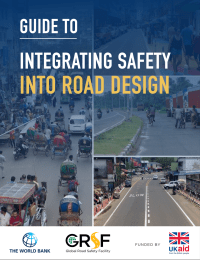
This guide focuses on elements of safe road and roadside designs for road networks that can provide safe mobility to all road users
A substantial reduction in road deaths will only be feasible if concerted efforts are made, following the “Safe System” approach involving all elements of road safety, management, and delivery. This includes all pillars of the Safe System—starting from road safety management, safe roads and roadsides, safe speed, safe vehicles, safe road users, and post-crash care. This guide focuses on elements of safe road and roadside designs for road networks that can provide safe mobility to all road users, as well as complementary changes to improve speeds, vehicle safety, road user behaviors, and post-crash care. A balanced road design must take into account these complementary system elements to maximize safety benefits. The energy carried by a moving object is proportional to the square of its speed. A well-designed “forgiving roadside” ensures that this energy is dispersed in a crash, and as a result, less energy is transferred to the occupants.
Road infrastructure design plays a vital role in road safety outcomes. Safe infrastructure supports other road safety pillars by encouraging appropriate road user behavior (such as appropriate speed and correct lane position) and by providing a forgiving road environment if things go wrong. Poorly designed road infrastructure can give rise to dangerous road user behavior. One of the key realizations of the Safe System approach is that drivers make mistakes and will continue to do so, even if we can reduce how often these occur. This road user error has long been recognized as a significant contributor to poor road safety outcomes. However, roads of any given speed can be designed to reduce the likelihood of crashes occurring, and there is very clear evidence that the severity of outcomes when crashes do occur is significantly influenced by the road design. Even if a crash still occurs, improved road infrastructure can save many lives and prevent debilitating injuries.
The Safe System approach highlights that a shared response is required to address road safety. This means that road users will continue to take responsibility for their actions, for instance by being alert and compliant with road rules. However, it is also recognized that road managers and designers have a significant responsibility to provide a road system that protects all road users. This can be achieved through appropriate designs of roads.

Chi phí thực sự của việc chạy quá tốc độ đối với con người và môi trường là bao nhiêu? 6 biểu đồ sau đây sẽ cho biết câu chuyện
Tác động của tốc độ đối với sự an toàn của người tham gia giao thông, tình trạng tắc nghẽn, ô nhiễm và tổng chi phí đi lại trên đường bộ thường bị hiểu sai: thường dựa trên những giả định sai lầm, với những tác động được coi là hiển nhiên, không xem xét nhiều tác động, nhiều bên liên quan chuyển chi phí ra bên ngoài và đánh giá thấp tác động (đặc biệt là chi phí kinh tế khi chạy với tốc độ cao). Mục đích của bản ghi chú ngắn này là cung cấp thông tin về những mối quan hệ này có liên quan đến các chính sách, thiết kế và hoạt động cơ bản của giao thông đường bộ. Bằng chứng rõ ràng cho thấy tầm quan trọng của việc quản lý tốc độ di chuyển để đảm bảo an toàn giao thông, hiệu quả, cải thiện sự hòa nhập và khí nhà kính (GHG) cùng các khí thải khác. Do đó, quản lý tốc độ là đòn bẩy chính sách mạnh mẽ đối với nhiều vấn đề cần được giải quyết để có khả năng di chuyển bền vững.
Giảm tốc độ di chuyển là một cơ hội lớn nhưng chưa được đánh giá đúng mức để cải thiện sự an toàn, tác động của biến đổi khí hậu đối với giao thông, sức khỏe, sự hòa nhập, nền kinh tế và trong một số trường hợp là tình trạng tắc nghẽn. Quản lý tốc độ có thể đạt được thông qua một loạt các biện pháp can thiệp bao gồm cơ sở hạ tầng đường bộ và công nghệ xe cộ, cũng như thực thi và thúc đẩy.
Sáu biểu đồ được trình bày trong ghi chú này kể một câu chuyện mạnh mẽ, trong phạm vi các lợi ích của việc quản lý tốc độ.




